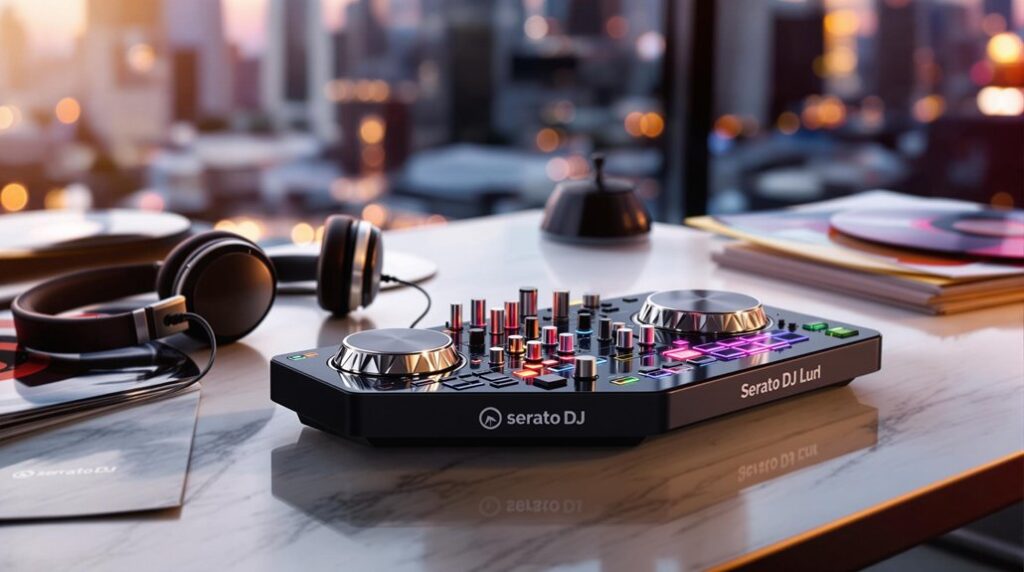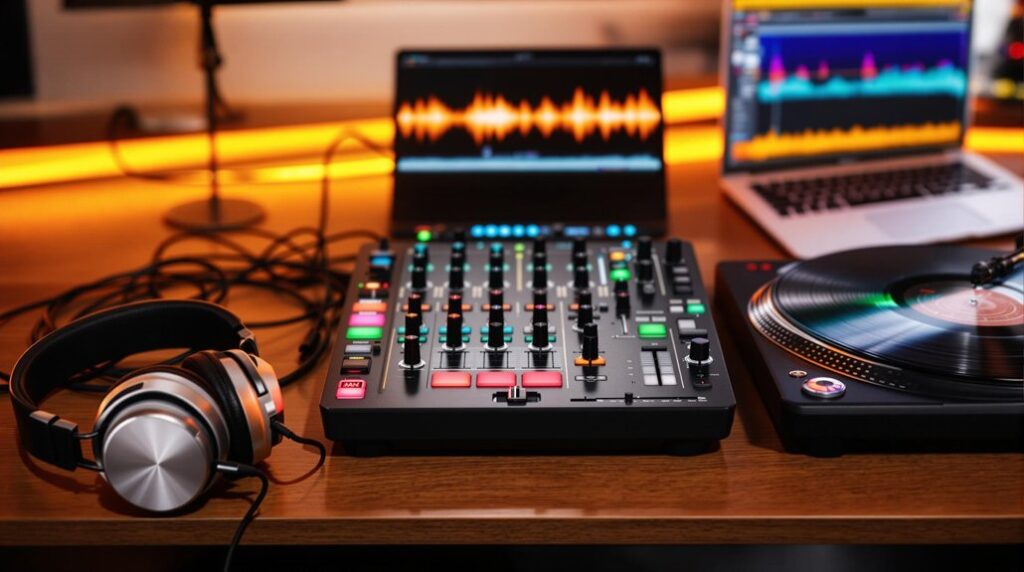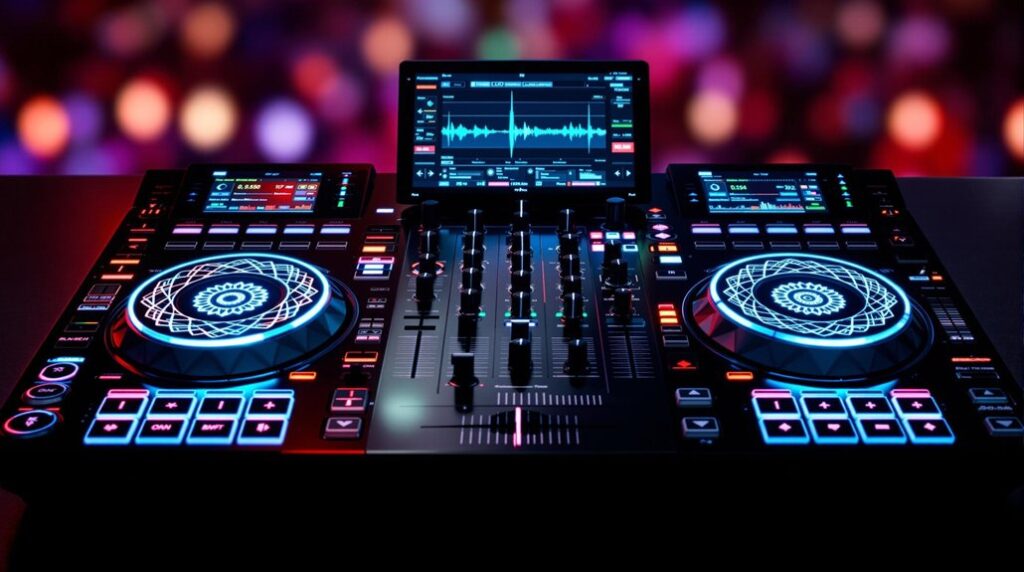A DJ mixing board is key for seamless live sets, comprising an audio interface, EQ knobs, faders, and a crossfader for precision sound control. Mixer channels allow for individual source management, utilizing gain and EQ settings to balance inputs. Effects, like reverb and delay, boost creativity. Cue buttons enable headphone monitoring, while routing controls facilitate diverse input selection. Enhance performance by linking sources and output, and implementing advanced tech integration. Discover the intricacies of mastering live audio.
Key Takeaways
- Ensure proper connections using RCA or XLR cables for audio source and output stability.
- Manage individual audio inputs with mixer channels and gain controls for balanced sound.
- Utilize EQ knobs to adjust frequency ranges and prevent audio conflicts.
- Employ the crossfader for seamless transitions between audio channels during live sets.
- Pre-listen to tracks using the cue button and headphone monitoring features for precise mixing.
Key Components of a DJ Mixing Board
A DJ mixing board, an intricate piece of audio equipment, is constructed with several essential components that facilitate the control and manipulation of sound.
Central to the DJ mixer is the audio interface, which manages multiple audio inputs and outputs. Each channel features EQ knobs for precise frequency adjustments and a fader to control channel volume.
The crossfader is vital for blending audio channels, allowing seamless shifts. A cue button linked to the headphone output enables pre-listening, ensuring track readiness without impacting the main output.
Routing controls efficiently manage audio signal paths, directing sound to desired outputs or monitors. Additionally, built-in effects such as reverb and delay enhance the auditory experience, providing DJs with creative flexibility in live performances.
For precision in mixing, real-time track analysis is a crucial feature that ensures accurate beat matching and synchronization of beats across tracks.
Understanding Mixer Channels
Mixer channels serve as the operational backbone of a DJ mixing board, each designed to manage distinct audio inputs with precision. Typically, a DJ mixer is equipped with multiple channels, featuring individual gain controls to meticulously adjust the volume of each audio source. Integral to this configuration are the EQ controls for bass, mid, and treble, enabling fine-tuning of frequency ranges to enhance sound quality within the DJ setup. The main channel volume control, or fader, plays an essential role in regulating output levels to the main mix, ensuring balanced sound delivery. Visual loudness levels on each channel are monitored via meters to avert clipping. The crossfader is vital for seamless shifts, blending audio from two channels and facilitating smooth track segues during live performances. Understanding tempo control is critical for maintaining consistent energy across sets, allowing DJs to focus on creative aspects of mixing.
Exploring Routing Controls
While exploring the intricate functions of routing controls on a DJ mixer, one uncovers their key role in the seamless integration of multiple audio sources. These controls are essential for live performances, facilitating smooth shifts between tracks.
A crossfader is instrumental, enabling quick changes between two audio inputs, enhancing dynamic mixing. The input matrix provides flexibility, allowing the selection of diverse inputs for individual channels, thereby optimizing the management of sound sources.
Channel volume controls are essential for balancing output levels, ensuring harmonious sound blending. Additionally, effects controls, whether built-in or externally connected, offer opportunities for enhancing sound quality and creative audio manipulation.
Surgical EQ cuts with narrow Q values can be employed to isolate and remove resonant problem frequencies, ensuring clarity and balance in the audio mix.
Collectively, these elements are significant for achieving a polished and professional live DJ performance.
Headphone Monitoring Features
Incorporating headphone monitoring features into a DJ mixing board is fundamental for achieving seamless shifts between tracks. These features, such as cue points (PFL), permit DJs to pre-audition tracks in headphones, ensuring the precise alignment necessary for uninterrupted DJ sets. Important to this process is the headphone mix volume control, which allows precision tuning of the cue track's volume relative to the main output, critical for clarity during live performances. Advanced DJ mixers further enhance control by enabling toggling between multiple channels, facilitating simultaneous track previews. The cue mix feature amalgamates audience sound with the headphone output, providing significant context. Quality monitoring is essential for maintaining beatmatching and phrasing accuracy, directly impacting the efficacy of live DJ performances. Advanced noise-cancelling technologies in DJ headphones maintain audio clarity in loud settings, which is crucial for precise monitoring during live sets.
Effects and Creative Sound Manipulation
DJ mixers are equipped with a range of built-in effects such as reverb, delay, and flanger, offering DJs the capability to manipulate sound creatively during live performances.
The inclusion of send/return loops facilitates the integration of external effects processors, thereby expanding the potential for intricate sound modulation.
Additionally, the real-time adjustment of EQ controls and crossfader positions enables seamless track shifts and dynamic mixes, essential for maintaining auditory engagement and energy.
Utilizing DJ software allows for real-time effects manipulation and customization, enhancing live performance creativity and offering DJs the ability to make instant adjustments during their sets.
Built-In Effects Variety
Built-in effects on DJ mixers serve as pivotal tools for sound manipulation, offering a range of enhancements such as reverb, delay, flanger, and echo.
High-end models excel in providing sophisticated, adjustable effects, allowing DJs to execute seamless shifts by controlling parameters like depth, feedback, and timing.
These assignable controls empower DJs to engage in mixing creativity during live performance, crafting unique soundscapes that captivate audiences.
The strategic use of built-in effects transforms ordinary tracks into immersive experiences, building tension and maintaining energy through techniques like filter sweeps and echo trails.
Mastery of these effects can greatly enhance a DJ's live set, creating memorable moments and showcasing their artistic prowess in sound manipulation and auditory architecture.
External Effects Integration
When DJs seek to expand their sonic palette beyond the limitations of built-in effects, integrating external effects units becomes an essential strategy.
A DJ mixing board often includes send/return loops, facilitating the routing of audio signals to external effects units like the Roland RE-20 Space Echo or the Eventide H9.
These units introduce advanced sound manipulation capabilities, offering effects such as reverb, delay, and distortion, vital for enhancing live performances.
Precise routing of effects allows DJs to layer and adjust parameters, achieving creative sound manipulation that can build tension or create drops.
Mastery of these techniques critically impacts the overall sound, providing DJs the ability to craft dynamic and engaging audio experiences during live sets.
Real-Time Sound Modulation
A multitude of effects such as reverb, delay, and filters enable real-time sound modulation, offering DJs critical tools for creative audio manipulation during live performances.
Many DJ mixing boards are equipped with built-in effects processors, eliminating the need for external devices, thereby streamlining the application of effects during sets.
Advanced DJ software, including Serato and Traktor, further enhances this capability by providing beat-synchronized effects that align seamlessly with the track's tempo.
Employing creative sound manipulation techniques like looping and sampling can greatly enhance shifts and raise set energy.
Additionally, precise use of crossfader and EQ controls facilitates smooth shifts and dynamic auditory changes, enriching the live performance experience.
This integration of technology guarantees DJs maintain innovative control over their sets.
Setting Up Your DJ Mixing Board for Live Performance
To enhance a DJ mixing board for live performance, it is imperative to establish robust gear connections by linking audio sources such as turntables, CDJs, or controllers to the mixer's input channels using RCA or XLR cables, thereby ensuring stable audio signal integrity. Following this, precise adjustment of the gain controls is essential to maintain ideal input levels, avoiding both noise from low levels and distortion from excessive levels, while achieving a balanced signal meter reading. Employing the EQ controls on each channel allows for meticulous sound shaping, enhancing audio quality and preventing frequency conflicts between concurrent tracks. To optimize your setup, consider using a Behringer UCA202 audio interface for cleaner audio signal via USB connection to your laptop, which can enhance sound clarity and reduce potential interference.
Essential Gear Connections
Successfully setting up a DJ mixing board for live performance requires precise attention to several critical connections.
The first step in the mixer setup involves connecting audio sources such as turntables, CDJs, or DJ controllers to the DJ mixing board using high-quality RCA or XLR cables. This guarantees peak sound quality and reliability.
The main output must connect to speakers or an audio interface with suitable XLR or 1/4-inch jack cables for robust signal transmission. For headphone monitoring, the designated headphone output on the mixer allows cueing and smooth shifts.
Meticulous adjustment of EQ controls—bass, mid, treble—on each channel is essential to avoid frequency conflicts. Effective cable management with ties or clips prevents tangling and maintains a professional appearance.
Mixer Channel Setup
When configuring a DJ mixing board for live performances, detailed attention to each channel's setup is paramount for ideal sound management.
The mixer channel setup begins with the gain control, or trim, essential for adjusting the volume of incoming audio sources. The EQ section comprising bass, mid, and treble controls allows for precise sound enhancement before integrating into the master mix.
Each channel's fader manages the output level, ensuring smooth shifts. The crossfader is critical for switching between audio sources, enabling seamless track blending.
Cue buttons (PFL) facilitate headphone monitoring of tracks before audience exposure. Mastery of routing controls is essential, allowing effective management of audio sources and effects, thereby crafting dynamic live sets with precision and finesse.
Frequently Asked Questions
What Is Needed for a Basic DJ Setup?
A basic DJ setup requires understanding DJ controller types, selecting suitable audio interfaces, choosing speakers wisely, meeting laptop specifications, managing music libraries, addressing software compatibility, integrating microphones, selecting headphones, and ensuring essential cables are accessible.
What Are the Fundamentals of DJ Mixing?
The fundamentals of DJ mixing encompass beat matching, precise EQ settings, managing audio signals, and mastering shift techniques. Tempo control, looping effects, strategic track selection, and diverse mixing styles are essential for a seamless live performance experience.
What Is the Difference Between a DJ Set and a Live Set?
A DJ set emphasizes mixing techniques, software integration, and curated DJ performance styles for rhythmic audience engagement, while a live set utilizes live sound technology, varied equipment, genre-specific setups, and stage presence for dynamic performance environment considerations.
What Is the Best DJ Equipment for Beginners?
For beginner gear, entry level controllers like Hercules DJ Control Inpulse 500 offer intuitive software options. Affordable mixers paired with quality headphones enhance sound quality. Portable setups with essential accessories and online learning resources support effective practice techniques for novices.
Conclusion
In sum, a thorough understanding of a DJ mixing board's key components, including mixer channels, routing controls, and headphone monitoring features, is essential for optimizing live performances. Mastery over effects and creative sound manipulation further enhances a DJ's ability to craft immersive auditory experiences. By meticulously setting up the mixing board, one guarantees seamless integration with other equipment, facilitating precision in audio delivery. This technical finesse is indispensable for achieving professional-grade live sets.




